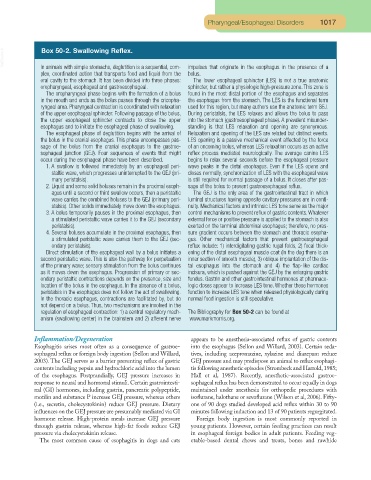Page 980 - Small Animal Clinical Nutrition 5th Edition
P. 980
Pharyngeal/Esophageal Disorders 1017
VetBooks.ir Box 50-2. Swallowing Reflex.
In animals with simple stomachs, deglutition is a sequential, com-
plex, coordinated action that transports food and liquid from the impulses that originate in the esophagus in the presence of a
bolus.
oral cavity to the stomach. It has been divided into three phases: The lower esophageal sphincter (LES) is not a true anatomic
oropharyngeal, esophageal and gastroesophageal. sphincter, but rather a physiologic high-pressure zone. This zone is
The oropharyngeal phase begins with the formation of a bolus found in the most distal portion of the esophagus and separates
in the mouth and ends as the bolus passes through the cricopha- the esophagus from the stomach. The LES is the functional term
ryngeal area. Pharyngeal contraction is coordinated with relaxation used for this region, but many authors use the anatomic term GEJ.
of the upper esophageal sphincter. Following passage of the bolus, During peristalsis, the LES relaxes and allows the bolus to pass
the upper esophageal sphincter contracts to close the upper into the stomach (gastroesophageal phase). A prevalent misunder-
esophagus and to initiate the esophageal phase of swallowing. standing is that LES relaxation and opening are synonymous.
The esophageal phase of deglutition begins with the arrival of Relaxation and opening of the LES are related but distinct events.
the bolus in the cranial esophagus. This phase encompasses pas- LES opening is a passive mechanical event affected by the force
sage of the bolus from the cranial esophagus to the gastroe- of an oncoming bolus, whereas LES relaxation occurs as an active
sophageal junction (GEJ). Four sequences of events that might reflex process mediated neurologically. The average canine LES
occur during the esophageal phase have been described. begins to relax several seconds before the esophageal pressure
1. A swallow is followed immediately by an esophageal peri- wave peaks in the distal esophagus. Even if the LES opens and
staltic wave, which progresses uninterrupted to the GEJ (pri- closes normally, synchronization of LES with the esophageal wave
mary peristalsis). is still required for normal passage of a bolus. It closes after pas-
2. Liquid and some solid boluses remain in the proximal esoph- sage of the bolus to prevent gastroesophageal reflux.
agus until a second or third swallow occurs, then a peristaltic The GEJ is the only area of the gastrointestinal tract in which
wave carries the combined boluses to the GEJ (primary peri- luminal structures having opposite cavitary pressures are in conti-
stalsis). Other solids immediately move down the esophagus. nuity. Mechanical factors and intrinsic LES tone serve as the major
3. A bolus temporarily pauses in the proximal esophagus, then control mechanisms to prevent reflux of gastric contents.Whatever
a stimulated peristaltic wave carries it to the GEJ (secondary external force or positive pressure is applied to the stomach is also
peristalsis). exerted on the terminal abdominal esophagus; therefore, no pres-
4. Several boluses accumulate in the proximal esophagus, then sure gradient occurs between the stomach and thoracic esopha-
a stimulated peristaltic wave carries them to the GEJ (sec- gus. Other mechanical factors that prevent gastroesophageal
ondary peristalsis). reflux include: 1) interdigitating gastric rugal folds, 2) focal thick-
Direct stimulation of the esophageal wall by a bolus initiates a ening of the distal esophageal muscle coat (in the dog there is an
second peristaltic wave. This is also the pathway for perpetuation inner section of smooth muscle), 3) oblique implantation of the dis-
of the primary wave; sensory stimulation from the bolus continues tal esophagus into the stomach and 4) the flap-like cardiac
as it moves down the esophagus. Progression of primary or sec- incisura, which is pushed against the GEJ by the enlarging gastric
ondary peristaltic contractions depends on the presence, size and fundus. Gastrin and other gastrointestinal hormones at pharmaco-
location of the bolus in the esophagus. In the absence of a bolus, logic doses appear to increase LES tone. Whether these hormones
peristalsis in the esophagus does not follow the act of swallowing. function to increase LES tone when released physiologically during
In the thoracic esophagus, contractions are facilitated by, but do normal food ingestion is still speculative.
not depend on a bolus. Thus, two mechanisms are involved in the
regulation of esophageal contraction: 1) a central regulatory mech- The Bibliography for Box 50-2 can be found at
anism (swallowing center) in the brainstem and 2) afferent nerve www.markmorris.org.
Inflammation/Degeneration appears to be anesthesia-associated reflux of gastric contents
Esophagitis arises most often as a consequence of gastroe- into the esophagus (Sellon and Willard, 2003). Certain seda-
sophageal reflux or foreign body ingestion (Sellon and Willard, tives, including acepromazine, xylazine and diazepam reduce
2003). The GEJ serves as a barrier preventing reflux of gastric GEJ pressure and may predispose an animal to reflux esophagi-
contents including pepsin and hydrochloric acid into the lumen tis following anesthetic episodes (Strombeck and Harrold,1985;
of the esophagus. Postprandially, GEJ pressure increases in Hall et al, 1987). Recently, anesthetic-associated gastroe-
response to neural and hormonal stimuli. Certain gastrointesti- sophageal reflux has been demonstrated to occur equally in dogs
nal (GI) hormones, including gastrin, pancreatic polypeptide, maintained under anesthesia for orthopedic procedures with
motilin and substance P increase GEJ pressure, whereas others isoflurane, halothane or sevoflurane (Wilson et al, 2006). Fifty-
(i.e., secretin, cholecystokinin) reduce GEJ pressure. Dietary one of 90 dogs studied developed acid reflux within 30 to 90
influences on the GEJ pressure are presumably mediated via GI minutes following induction and 13 of 90 patients regurgitated.
hormone release. High-protein meals increase GEJ pressure Foreign body ingestion is most commonly reported in
through gastrin release, whereas high-fat foods reduce GEJ young patients. However, certain feeding practices can result
pressure via cholecystokinin release. in esophageal foreign bodies in adult patients. Feeding veg-
The most common cause of esophagitis in dogs and cats etable-based dental chews and treats, bones and rawhide

